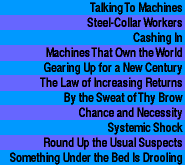


The Law of Increasing Returns
In the early stages of a new information industry most economic theory doesn't apply. Economists usually assume that resources are limited, that production methods are fixed, and that there's enough time for markets to stabilize. Most economists are used to waiting until the sediment settles and everything is once again clear.Here, for instance, is the standard economic model of a new product's introduction. In the beginning, there are a small market, small production runs to supply it, crude manufacturing equipment, and many small suppliers---because the cost of entering the market is low. With competition, either prices fall or quality rises. In either case, profit margins decrease and suppliers have to pump up volume to maintain turnover and market presence. As competition escalates, development costs rise, the number of suppliers shrinks, and bigger companies enter the market. Consumer expectations then rise and companies start competing on customer satisfaction (service, reliability, packaging, marketing) rather than on price. The price is now reasonably fixed and technological change is relatively stable. Apart from minor fluctuations, everything becomes static.
That model fits limited-resource markets like agriculture, mining, utilities, and bulk goods, where there's a fixed resource and little technological change. But it has little to say about information markets like communications, entertainment, education, publishing, computers, pharmaceuticals, robotics, and biotechnology. In those markets, information isn't necessarily limited. Further, there's no single stable point; there are many. Finally, there may not be time to reach stability before the next major change occurs. Someone is always throwing another boulder into the economic pond.
Information markets need a big initial investment for design and tooling but can sustain enormous price reductions with increasing market growth. Such growth is further compounded by positive feedback: as markets increase, production can grow radically more efficient and returns can increase enormously.
Today, design costs dominate the price of information technology. Yet we still speak of hardware (tangibles) and software (intangibles) as if there were still a great distinction between them, even though less than 2 percent of the cost of a computer chip is from raw materials. A chip has thus already become as much a piece of software as a program is. We're rapidly moving toward an economy based, not on energy and raw materials, but on information and computation. Building a new computer chip, inventing a new gene therapy, or designing a new drug isn't like building a dam or opening a new car factory. Most of the costs are in design and tooling, not energy, raw materials, and maintenance.
The potentially large profits of information technology inflate both the number of people attracted to work on the remaining problems and the number of people wanting to use the improved products. Both serve to fuel the development of even better products. Like a snowball rolling down a snow-covered hill, the bigger it is, the bigger it gets. For example, as more of us bought fax machines, more of us wanted fax machines---to talk to those who already had them. And, as more of us got them, more people set to work improving them. Unlike, say, refrigerators, the more fax machines there are, the more a new one is worth. Today, fax transmissions account for a quarter of all American domestic telephone calls and roughly half of all trans-Pacific volume.
Finally, the exponential improvement typical of the information revolution is being applied to a group of coupled technologies. Improving any one technology improves other technologies in the group, which in turn help improve the original technology. For example, better computers improve communications, which improves science and engineering, which improve instruments and design tools, which close the loop by improving computers.
The differences between the development of older technologies and information technology have consequences for industry. Many information executives still seem to see the world in the classical order: shareholder, supplier, shopper, staff, society. That order reflects a world where capital is the most important thing. It works well in a stable, fixed-resource economy. But in a fast-changing, near-endless-resource information market, the priorities should be different: shopper, staff, society, supplier, shareholder. In such markets, the shopper matters more than the shareholder. Competing equipment vendors give the shopper more real choice and the shareholder's money matters less since equipment costs are low relative to everything else. Alas, something that's easy to see may not be all that easy to apply; tradition is hard to change.